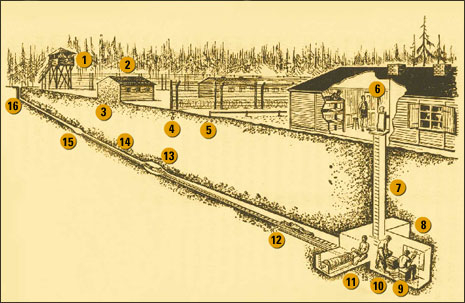
1. Goon Box
The prisoners called their German guards "goons" and the watchtowers "goon boxes."
One goon box on the edge of the prison camp stood a mere 45 feet from the spot
where Harry's exit shaft would eventually emerge.
2. Cooler
Stalag
Luft III's solitary confinement block, which prisoners dubbed "the cooler,"
was a routine destination for any prisoner who broke the rules. The duration of
a POW's stay depended on the whim of the German guards, but any prisoner caught
conspiring to escape could count on several weeks on the inside.
3. Sand
The
prison's architects intentionally sited it in an area where the subsoil was
bright yellow sand. The supple sand, they believed, would make tunneling nearly
impossible. Also, it would be easy for the guards to pick up on digging
activity if they noticed sand anywhere above ground.
4. Microphone
The
Germans buried microphones beneath the camp's barbed wire fences so they could
listen for sounds of prisoners digging out. The prisoners deliberately dug
Harry and other tunnels deep enough to be beyond the mikes' range.
5. Warning wire
A
knee-high wire that ringed the inside of the camp's perimeter fence sent a
signal to the guards on contact. Any prisoner who crossed it would be shot.
6. Trapdoor
The
entrance to Harry was tucked beneath a heating stove. The prisoners rebuilt its
concrete base and fashioned a flexible stovepipe extension so that the stove
was moveable. During digging the stove was never without a fire, discouraging
guards from coming too near. From its open position, the trapdoor could be
closed and sealed in 20 seconds using wooden handles on the stove.
7. Entrance shaft
The
wooden footholds leading to Harry extended down a claustrophobically narrow
30-foot shaft, past sound-absorbing blankets stuffed around the trapdoor, and
through an initial column of solid brick and concrete that had taken the
diggers days to chip away.
8. Storage Chamber
In this storage space, the men kept their extra supplies and bags of sand ready
to be moved aboveground for dispersion. During the later stages of the
tunneling, this chamber held items critical to the prisoners on escape night,
such as forged immigration papers, street clothing, and provisions.
9. Shoring
Constructing Harry in a substrate of sand meant that it was easy to dig but
difficult to maintain. Each new length of the tunnel had to be carefully shored
with wood lest it cave in. The process, shown here, involved laying
two-foot-long wooden bed boards into the sand ceiling and walls of the tunnel,
which was one just board high and one wide.
10. Workshop
This chamber served as a manufacturing workshop where the airmen made equipment
such as digging tools and lamps out of scavenged materials. In all, they
"borrowed" approximately 4,000 bed boards, 35 chairs, 50 tables, 90 bunk bed
frames, 1,600 blankets, and 1,400 tin milk cans during the construction of
Harry and two other tunnels, Tom and Dick.
11. Air pump
Fresh air was limited underground, so the prisoners devised an air pump for
Harry modeled after one they saw in a smuggled magazine. The pump, seen here,
consisted of a fabric bellows mounted on wooden runners. A man operated it back
and forth like a rowing machine to pump air through milk-tin ventilation pipes
installed along the tunnel floor. A fresh-air intake vent was concealed in Hut
104.
12. Railroad
Diggers built a wooden railway along Harry to carry men or boxes of sand on small
rope-operated trolleys. The railway revolutionized the sand removal
process, allowing diggers to efficiently port tons of sand from within the
tunnel back to its entrance shaft, from where it was later dispersed or buried
around the camp. On escape night, the railway swiftly ferried the POWs through
Harry to the exit shaft.
13. Piccadilly Circus
Piccadilly was the first of Harry's two halfway changeover stations, each a
third of the way along the tunnel. Here, prisoners transferred themselves to a
new trolley for the next leg, whether heading back or going forward.
14. Lights
From the beginning, the underground darkness posed a challenge. At first, the
prisoners lit the way using homemade mutton-fat lanterns with pajama-fabric
wicks. When the lanterns proved noxious and unreliable, two intrepid POWs
snatched electrical wire from German workmen and installed lighting in the
tunnel, tapping into Stalag Luft III's circuit board.
15. Leicester Square
The POWs called the second changeover station Leicester Square. At this point
in the tunnel, a prisoner on the night of the escape was less than 100 feet
from his exit to freedom.
16. Exit shaft
During the first nine days of March, diggers cleared the last 100 feet of
tunnel Harry and created an exit shaft, seen here. By March 14, they had dug
upward almost to the surface, leaving two feet of earth to be removed the
night of the escape. Harry proved nearly 30 feet short of its intended mark.
Its exit shaft cleared the prison's perimeter fence but did not make it to the
cover of trees beyond.

| 

